
The present article is an abridged version of an article in Japanese and provides an overview of Chinese Telegraph Code (CTC). It should be noted that it is not something like telegraph codes in Europe and America or Japan, which assign code words/numbers to plaintext words and phrases in order to reduce telegraph cost. Whereas telegrams can be generally expressed with 26 letters in English and other European languages or with some fifty kana in Japanese, there is no counterpart for such alphabetical letters or kana in Chinese, which uses thousands of ideographic characters. Thus, a telegraph code to represent Chinese characters with four figures was indispensable in order to send telegrams in Chinese at all. Thus, Chinese Telegraph Code may (perhaps more properly) also be called Chinese Character Code (CCC). Of course, there are phonetic representations of Chinese such as pinyin, pronunciation may vary depending on dialects (Mr. Wu in Mandarin becomes Mr. Ng in Cantonese) and, even with the standard Mandarin, there are various romanization schemes (including the classic Wade Giles system etc. as well as pinyin). In order to uniquely identify names in Chinese, the Chinese Telegraph Code is extensively used in law enforcement/immigration control. (Wikipedia (English); explanation of DS-160 visa application by US embassy in Beijing; this also refers to "Telecode Name Used"; for Australia, try googling "Chinese commercial code numbers")�D
To briefly summarize the development of the Chinese Telegraph Code described below, a Frenchman Viguier created Dian bao Shu ji (�d��) [literally, "Telegraphic Book"] (1871) and its revision Dian bao Xin shu (�d��V��) ["Telegraphic New Book"] (1872), right after the introduction of telegraphy into China. These represented each character with a four-figure number. When the telegraph office was established by the Qing government in cooperation with the Great Northern Telegraph Company, there appeared Dian bao Xin bian (�d��V��) ["Telegraphic New Compilation"] (1881), renovated by a Chinese, which formed the basis of the Chinese telegraphic codes up to now. (On the other hand, the Qing government used revisions of Dian xin Xin fa (�d�M�V�@) ["Telegraphic New Law or Method"] (originally 1871) as official secret codebooks, and introduced a "Mi zhi" format, which anticipated the "Ming mi" format below. These official secret codebooks are described in another article.)
Ming mi ma dian bao shu (�������d��) ["Plain/Secret Code Telegraphic Book"] (1908) published from the Commercial Press employed blank row/column at the top/edge of each page for use in providing alternative code numbers, which established the "Ming mi" format that can serve both plain code ("ming") and secret code ("mi"). Ming mi Dian ma Xin bian (�����d���V��) ["Plain/Secret Telegraphic Code New Compilation"] by the government, of which the first edition came out in 1929, introduced alphabetical three-letter code (from the 1933 edition, according to the description in the Standard Telegraph Codebook (images, Chinese text)). After World War II, there are two streams of Biao zhun Dian ma Ben ["Standard Telegraphic Code Book"] (1952; extensively revised in 1983) of the People's Republic of China and Dian ma Xin bian ["Telegraphic Code New Compilation"] (1950) of Taiwan.
Before Numerical Codes (1851-1865)
From Dian bao Xin shu (1871/1872) to Dian bao Xin bian (1881)
Ming mi Ma Dian bao Shu and Ming mi Format for Secret Code (1908-1963)
Official Ming mi Dian ma Xin bian and Other Editions (1929-1950)
Biao zhun Dian ma Ben (Standard Telegraph Codebook) of the People's Republic of China (1952- )
Dian ma Xin bian of Taiwan (1950- )
This section describes attempts to telegraph a message in Chinese before telegraphy was even introduced in China in accordance with a very detailed account by J. McVey: Escayrac de Lauture (1826-68), amateur language engineer. Follow the link for further information including references and images.
An American missionary Daniel Macgowan considered a dial telegraph, an early telegraph device that transmits information by the direction of a needle on a dial, to be a suitable means for transmission of Chinese (Bo wu Tong shu, 1851). Specifically, his proposal involves using a dial plate with a needle that can indicate 16 positions to specify the type and location of each stroke of a Chinese character.
Marquis d'Escayrac (Wikipedia (French)) considered Macgowan was on the right track and, in considering what elements other than strokes Chinese characters could be reduced to, noted that combinations of radicals and phonetic elements could account for 95% of all Chinese characters.
The character table contained in a work of 1862 identifies a character by iteratively selecting one of four quadrants in a square table. Specifically, the character table contains the following square tables:
Square tables representing radicals (in blue): three tables of 4x4, 8x8, 16x16
Square tables representing phonetic elements (in red): four tables of 4x4, 8x8, 16x16, 32x32
Square tables representing symbols etc. (in yellow): two tables of 4x4, 8x8
For example, the most important radicals are contained in the following 4x4 square table:
| �� | �| | �S | �l |
| �� | �� | �� | �� |
| �� | �� | �� | �� |
| �� | � | �� | �R |
A character in this table can be identified by combinations of four symbols: "top-left point", "top-right point", "bottom-left line", and "bottom-right line" (which may also be represented by figures 1, 2, 3, and 4), representing the top-left, top-right, bottom-left, and bottom-right quadrants, respectively. For example, in order to represent "��", since the top-left 2x2 quadrant is first selected, in which the bottom-left square is then selected, the character is represented with a "top-left point" and a "bottom-left line". (Since the distinction of top/bottom can be reflected by either a point or a line, symbols "left point" and "left line" suffice.)
A character belonging to an 8x8 square table may be represented with three symbols such as "bottom-right line", "top-left point", and "bottom-left line." The size of the table to be referred to can be determined by the number of symbols.
Since there may be more than one table of the same size, the position combination is preceded by an indicator such as a "top-left point" for a radical (used as a character on its own), a "top-right point" for a phonetic element (used as a character on its own), and a "top-left line" for a "double" consisting of a radical and a phonetic element.
A work of 1865 also relies on combinations of radicals and phonetic elements but it utilizes Morse code. Escaryac employed the idea of Marcelin Legrand's composite printing method, whereby types for radicals and phonetic elements are combined to form characters. Since each element has a number assigned for a workman, one might transmit "simpler and shorter signals" instead of those numbers. The question is simpler for telegraphy than for typography, in which the same radical or phonetic element may receive different forms depending on its position in a character.
In the end, however, Escaryac's ideas were not accepted into practice.
Although numerical code may seem obviously the simplest choice from the modern perspective, it was never the case at the time. One review of Macgowan's scheme concluded that "communications in Chinese can only be intelligibly conveyed by describing the characters in some such way as Dr. Macgowan here proposes." Marquis d'Escaryac also considered it was on the right track and certainly better than a scheme in which each character was given its unique number. Still, a few years after Escaryac's proposals emerged numerical code for Chinese characters.
Submarine telegraph cable from Europe reached Singapore in 1870 and Shanghai in 1871. Meanwhile, the Great Northern Telegraph Company based in Denmark opened a land line up to Vladivostok in January 1872, before which it started cable communication between Shanghai and Hong Kong, between Nagasaki and Shanghai, and between Nagasaki and Vladivostok in 1871. The submarine cable at Shanghai, however, was not authorized by the Chinese government. It was only in 1881 that the Chinese government set up a telegraph office and officially authorized the Great Northern Telegraph Company.
At the request of the Great Northern Telegraph Company, a Danish astronomer Hans Schjellerup formed a basis for a code for use in transmitting Chinese characters. He studied Chinese eclipses (among others) and in 1869 proposed numbering of 5454 Chinese characters. (Wikipedia (English), (German))
French title: T'een-piao-shu-tsieh ou Code de Télégraphie Chinoise. Printed at the American Presbyterian Mission Press, Shanghai, 1871.
The Chinese Recorder and Missionary Journal, Vol.5, p.53 has a review of this volume as Teen paou shoo tseĭh.
Septime Auguste Viguier, a Frenchman working at the customs in Shanghai, prepared a character code based on Schjellerup's numbering and published it in 1871. The completion was in May 1871, the month after the service between Shanghai and Hong Kong started in April. It goes without saying that even before the completion of the codebook, Europeans in China must have used telegraphy in English etc. (see Robert Hart's letter quoted in another article).
According to the introductory notes both in French and English, Viguier first considered representing a character with three numbers representing a radical, a column under a radical, and a place in a column, respectively. This shows that a four-digit code was not an obvious option at the time.
This is a large volume with a height of more than 40 cm. A grid with 42 (vertical) columns, each with 26 characters, covers a two-page spread. The arrangement of characters is based on radicals and the number of strokes, as is common in dictionaries of Chinese characters.
Also interesting is the descrpition of an "expedition board" and a "reception board", tools for encoding/decoding. The expedition board has stamps arranged in the same way as the codebook. The reception board has stamps arranged in the order of the code number, whereby one can decode by only using the right stamp corresponding to a code number. The large format of this volume may have been chosen to allow correspondence with these boards.
Viguier also says the code could be used for text enciphered with transposition as was done by Chinese. He appears to have been concerned about the Chinese government's opposition to laying telegraph lines.
French title: T'een piao hsin-shu ou Nouvelle Edition du code de Télégraphie Chinoise. Again printed at the American Presbyterian Mission Press.
Det Kongelige Bibliotek has an extra cover before a red title page. The copy at Toyo Bunko (Tokyo) has the same title page but also includes title pages and prefaces in French for the 3rd and 2nd editions. The Boston International Antiquarian Book Fair also has a photo for the 3rd edition.
T'een-piao-shu-tsieh published in 1871 was a success and both the 1st and 2nd editions were rapidly exhausted, which led to publication of the 3rd edition in 1873. According to the title pages in French, the 2nd edition was created in 1871 and printed in 1872 and the 3rd edition was created in 1871 and printed in 1873. This implies the code itself remained unchanged from the 1871 first edition.
In contrast to the large volume of the first edition, T'een piao hsin-shu was of a handy format. The body of the code employs a grid with 10 (vertical) columns, each with 20 characters. Each of the 200 characters on a page has a four-digit number assigned to it. The arrangement of characters is based on radicals and the number of strokes, as is common in dictionaries of Chinese characters. The last code number is 6899 but, since there are blanks, the last character corresponds to 6893. According to the preface of the 3rd edition, it employed Chinese numerals, as opposed to Arabic numerals employed in the 1st and 2nd editions.
(Somehow, the title page of the 2nd edition has the same title as that of the 1st edition. But Viguier's memoirs (Viguier, Mémoire sur l'Etablissement de Lignes Telegraphiques en Chine, Imprimerie Carvalho & Cie, Shanghai (1875), 26pp.) gives the 3rd edition the same title as that for the 2nd edition. Further, the red title page of the 3rd edition bears an indication of the year 1872 and a title T'een piao hsin-shu. Thus, I think the 2nd edition had the same title as the 3rd edition.)
As with T'een-piao-shu-tsieh, Viguier paid attention to secrecy of telegrams. This time, on p.6-9 (page numbering being according to digital images at Det Kongelige Bibliotek), it appears measures for secrecy are described, in which a preconcerted four-digit number is added to a code number digit by digit without carry. For example, adding a key 5555 to a code number 4649 results in 9194.
Specimens of telegram forms are shown on p.10-12: one in plaintext on p.10, one in code on p.11, and one in code superenciphered with a key 5071 on p.12, where names, place names, addresses, etc. are not to be superenciphered.

Based on Viguier's code, De Mingzai (Tê Min Tsai in the classic Wade Giles romanization) provided this improved version. According to the English version of the preface (p.8-9) dated "Paris, November, 1871" by C.M. Têh (apparently standing for Têh Mincai), Viguier's code was brought to the author's notice when he was in Europe as attaché to the Chinese mission to France and he felt there was room for improvements.
There were new features such as a character index (p.10-23) or entries for letters of the Latin alphabet and Arabic figures (p.97-). The most remarkable feature may be in the arrangement of the code body (p.24-97). Now, one page contains 10x10=100 characters and each new radical starts a new column, with blanks at the end of the preceding column. The code numbers are in Arabic figures. Since there are much more blanks than in Viguier's code, the last character is given the number 7344.
Specimens of telegram forms are shown on p.98-99: one in plaintext on p.98 and one in code on p.99, each containing "The Great Northern Telegraph CHINA AND JAPAN EXTENSION COMPANY" in English on the top, which appears to be a header of the telegram form of the Great Northern Telegraph Company.
Revisions of Dian xin Xin fa were used as official secret codebooks (see another article).
Google (This copy appears to be an 1897 edition, judging by the Chinese year given to the tariff therein. A 1911 edition is also listed at Google. A page image of an 1882 edition is found in a Japanese book (Yasuoka et al. (2006) p.26).

This was compiled in 1881 by Zheng Guangying, who noted confusion in arrangement and insufficiency of entries of Dian bao Xin shu (Wikipedia (Japanese)).
It follows the format of Dian bao Xin shu of 200 characters on one page and code numbers in Chinese numerals but its code assignment is different from that of Dian bao Xin shu or Dian xin Xin fa. In the 1897 version above, the last character number is 9651. Judging from the arrangement of characters, the numbers 8001 and thereafter are supplements. The last character number before the supplement is 7902.
The front matter includes a tariff and 35 articles of service rules. The second article appears to describe a scheme for addition/subtraction of a prearranged number in order to keep secrecy. For example, a key 20 may be added to 6635 0796 5074 to result in 6655 0816 5094. (This is different from digit-by-digit addition without carry in the case of Viguier's Dian bao Xin Shu.)
Telegraphy in Korea started in 1885. What appears to be a Korean version with substantially the same content as Dian bao Xin bian (1881) is mentioned here. At the time, telegrams had to be written in either Chinese characters or European letters, not Hangul.
This communication handbook includes a character code on p.126-37 (with p.37 being the last). From the page image, while it has a 100-character-per-page format, the code assignment appears to be the same as that of Dian bao Xin bian (1881).
This suggests that Dian bao Xin bian (1881) was the mainstream code at the time but Viguier's Dian bao Xin shu appears to have been still in use. Since the latter had less entries than the former and had other problems, the Great Northern Telegraph Company stopped use of Dian bao Xin shu in 1924.
"Si jiao hao ma" refers to the Four-Corner Method, which is one of Chinese character looukp methods without relying on radicals (Wikipedia (English))�DIt appears Dian bao Xin bian was included as an appendix ("Fu").
About the time of the Chinese Revolution of 1911, new features were introduced to Chinese telegraphic code.

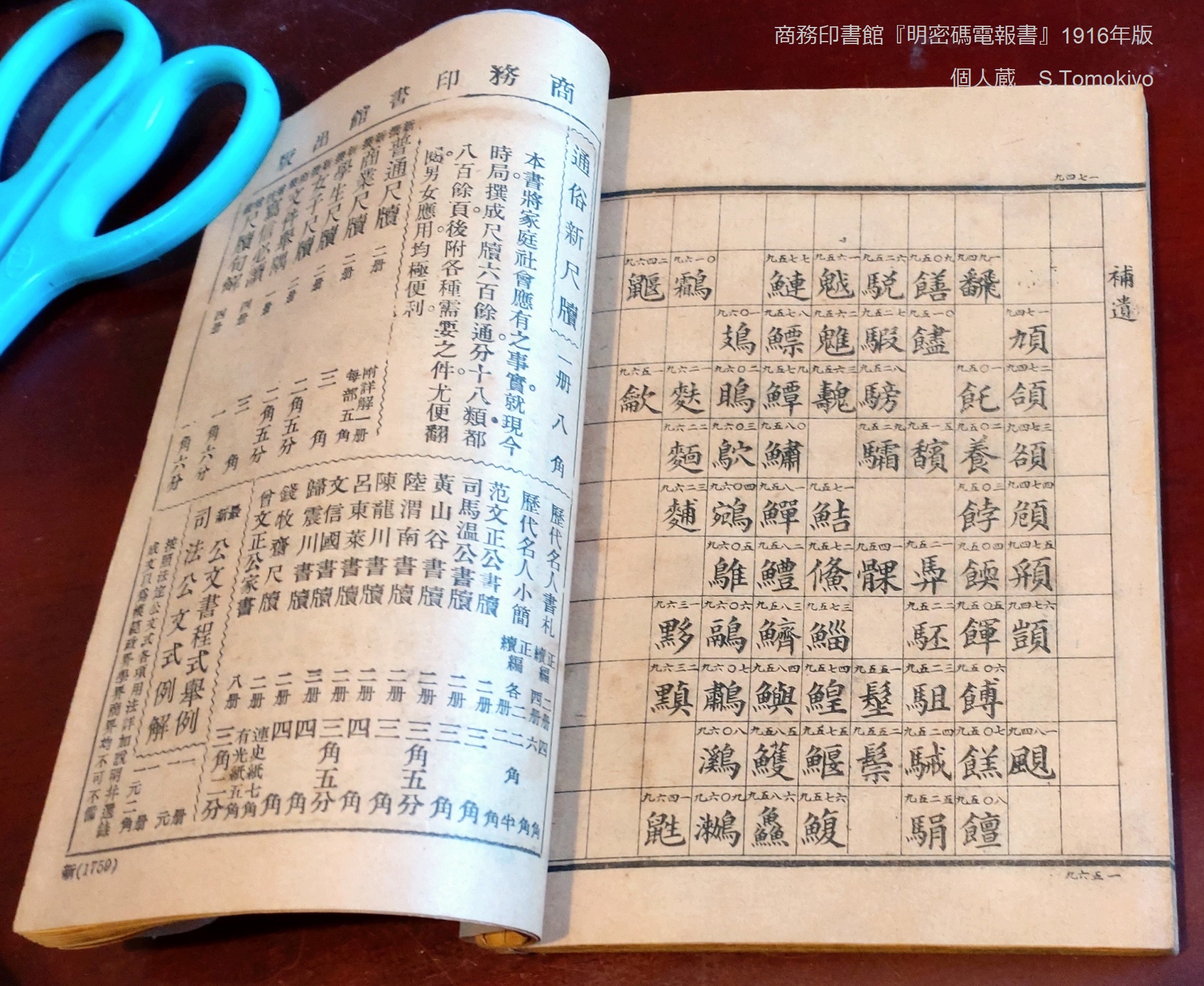

In September 1908, Ming mi Ma Dian bao Shu was published from the Commercial Press. The Commercial Press (Shangwu Yinshuguan) (established in 1897) (Wikipedia (English)) appears to be one of major publishers in China along with Zhonghua Book Company (Zhonghua Shuju) (established in 1912) (Wikipedia (English)) mentioned below etc.
Here (details here) are images of a 1916 edition. A 1913 edition is at the Tokyo Metropolitan Library. The following is based on the latter edition.
The introduction appears to describe that secret code ("mi ma") is good for secrecy but plain code ("ming ma") is necessary for names and addresses; that the codebook includes all of Dian bao Xin bian and provides blank rows/columns which allow arrangement of secret code.
Each page of the code contains 10x10 characters in 10 vertical lines and has a blank row/column on the top and edge. The blanks allow users to prepare secret code of their own. In the particular copy of the Library, the top blank row is filled in with Chinese numerals 8, 6, 4, 1, 5, 2, 9, 0, 7, 3 (from left to right) and the blank column on the left edge is filled in with Chinese numerals 5, 3, 8, 7, 9, 4, 0, 2, 1, 6 (from top to bottom). The same numerals are written on every page. In addition, each page has a different two-figure number written in the margin ("81" for page 1, "27" for page 2, "35" for page 3, etc.). With these handwritten numerals, the holder of the codebook can assign four-figure code numbers different from the default code numbers by combining page number (2 digits)+column number (on the top)+row number (on the edge).
The default code assignment appears to be substantially the same as that of Dian bao Xin bian (1881).
Such a 10x10 format with blank rows/columns for providing secret code established the basis of subsequent Chinese telegraph codes.
Editions from the Commercial Press include those of 1932, 1936, 1939, 1941, 1946, 1949, 1959, 1962 (Shanghai) and that of 1952 (Taiwan) listed on the Web (Google, WorldCat, etc.).
Here is also a cover image (Commercial Press).
Under the same title Ming mi Ma Dian bao Shu, here are images of a 1922 edition (Zhonghua Book Company, Shanghai). In particular, there is an image of two pages covering 0101-0300 (vertical reading, Chinese numerals, no alphabetical letter code). The code assignment appears to be the same as that of Dian bao Xin bian (1881). There is a blank row/column on the top/edge of each page as above. Here is an image of a front cover with a similar format but with the year 1932.
Here are some images of a 1940 edition (Commercial Press). The code assignment for days and times appears to be the same as that of the 1941 revision below, while the stroke counts on the margin cannot be seen.
The edition here appears to be a 1963 edition (Commercial Press, Hong Kong) but the website appears to describe this as "first revised edition March 1941; printed in July 1963." (After writing this, I obtained a copy of 1968 as shown below.)
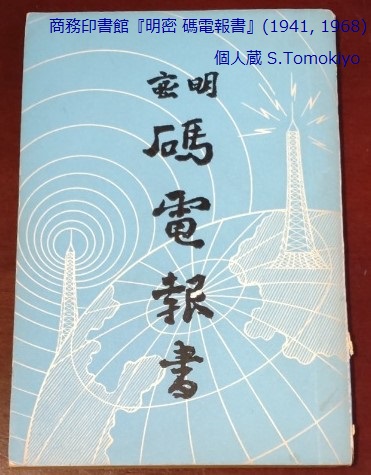

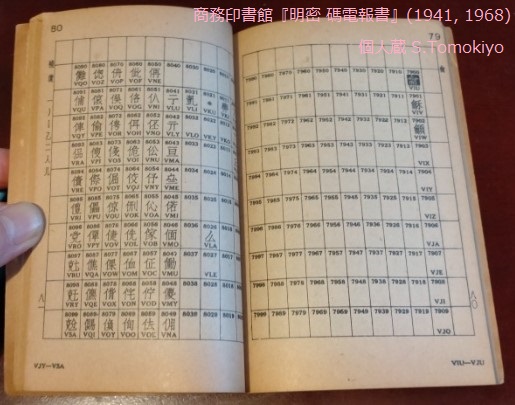
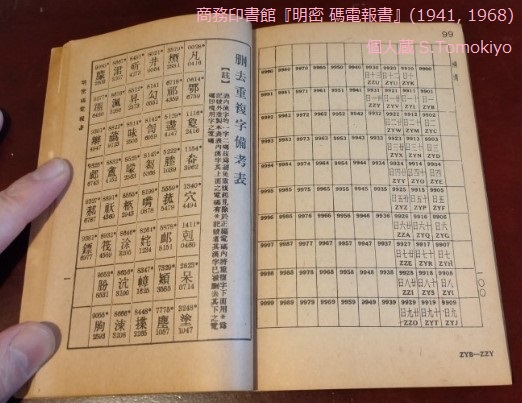
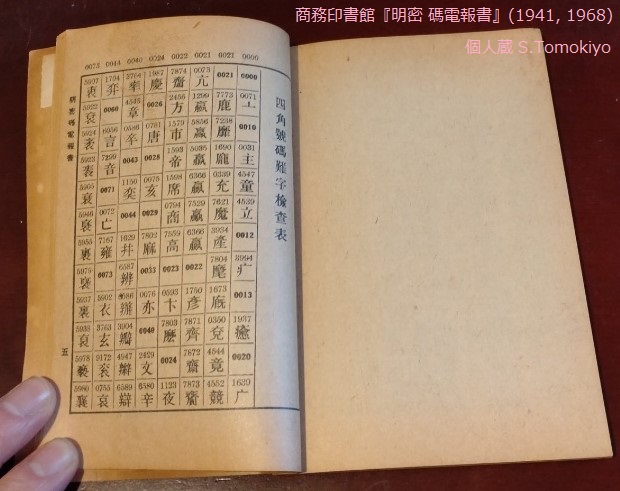
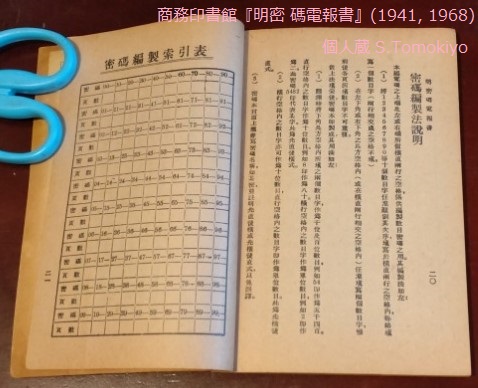
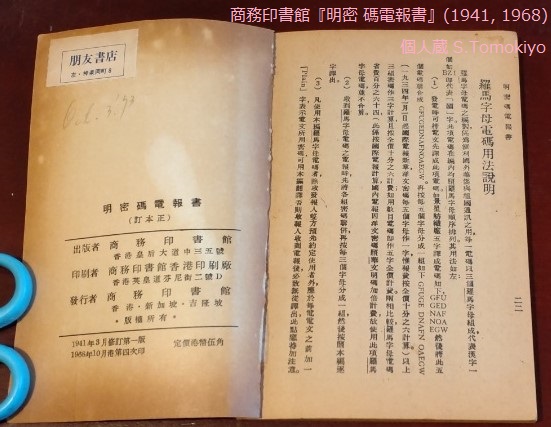
The code assignment seems to be the same as that of Dian bao Xin bian (1881). (There are a few differences such as 0028 being "*".)
This code has some features as in the official Ming mi Dian ma Xin bian (1933) described below, including three-letter alphabetical code groups in addition to the four-figure code numbers. In the bottom margin are stroke counts of elements in Arabic figures to facilitate lookup.
The appendix includes, among others, a table defining code numbers and three-letter code groups for days and hours (9901 the 1st, ..., 9931 the 31st etc.) as well as a table collecting code numbers and three-letter code groups of characters used to represent days of the month.
The edition of this blog appears to have been published in 1941. Although the publisher is not identified, the features seem similar to those of the 1941 revision above. There are images for two pages showing about 2301-2498 (vertical reading), which employs Arabic figures and alphabetical three-letter code groups. The code assignment appears to be the same as that of Dian bao Xin bian (1881). There is a blank row/column on the top/edge of each page as above.
With a slightly different title Ming mi ma Dian bao Shu (with "ming mi ma" in small letters as a prefix), here are several images of a 1945 edition (Taiwan). In particular, the images show codes around 1301-1377 (vertical reading, Chinese numerals, no alphabetical letter code). The code assignment appears to be the same as that of Dian bao Xin bian (1881). There is a blank row/column on the top/edge of each page as above.
In 1929, the Ministry of Transportation and Communications of China issued Ming mi Dian ma Xin bian. In 1933, a supplement added about 1000 characters. Google lists editions of 1933, 1937, 1946, 1948, 1949, 1950.
Here are some images from the 1933 edition. It includes 297 pages, of which the code body must be less than 100 pages. The appendix includes, among others, a table of additional characters; a table defining codes for days and hours; and a table collecting codes of characters used to represent days of the month.
Each page contains 10x10 characters (vertical arrangement as before) and a blank row/column is provided on the top/edge. Code numbers are in Arabic figures. The images for four pages including 0101-0200, 1101-1200, 2101-2200, and 3101-3200 can be seen, in which code assignment appears to be generally the same as Dian bao Xin bian (1881). One exception is deletion of the character for 1154. In the bottom margin, the number of strokes for the part other than the radical is noted in Arabic figures in order to help lookup.
In addition to the four-digit code numbers, there are alphabetical three-letter code groups, which appear to be assigned sequentially as AAA, AAB, AAC, ... (the feature not present in the 1929 edition). In the 1930s, with the removal of the requirement that code words shall be pronounceable in the international telegraph rules, three-letter codes were appearing in the West as well as in Japan (see another article).
A Japanese book (Yasuoka et al. (2006)) provides a page image (codes 0000-0099) of a 1935 edition. It employs horizontal reading as opposed to the traditional vertical reading. A blank row/column is provided on the top/edge. The code assignment is generally the same as that for Dian bao Xin bian (1881), except for 0028, 0053, and an added blank code number 0000. It is said to include 8848 characters and 55 special codes for dates. (The features such as horizontal reading and zero origin are seen in the image reproduced in Alan Stripp, Codebreaker in the Far East, p.138, which appears to be taken from a Japanese or Chinese book and contains page 4, including codes 0300-0399, and page 5, including "Explanatory Notes" in English with instructions such as "first ascertain the radical .... a short search on page 1 will yield the code expression ....")
In addition to the four-digit code numbers, there are alphabetical three-letter code groups, which appear to be assigned sequentially as AAA, AAB, AAC, ....
A cover image of a 1948 edition is found at a website of a store in Taiwan (the title is written vertically). It appears to employ Arabic figures and alphabetical letter code.
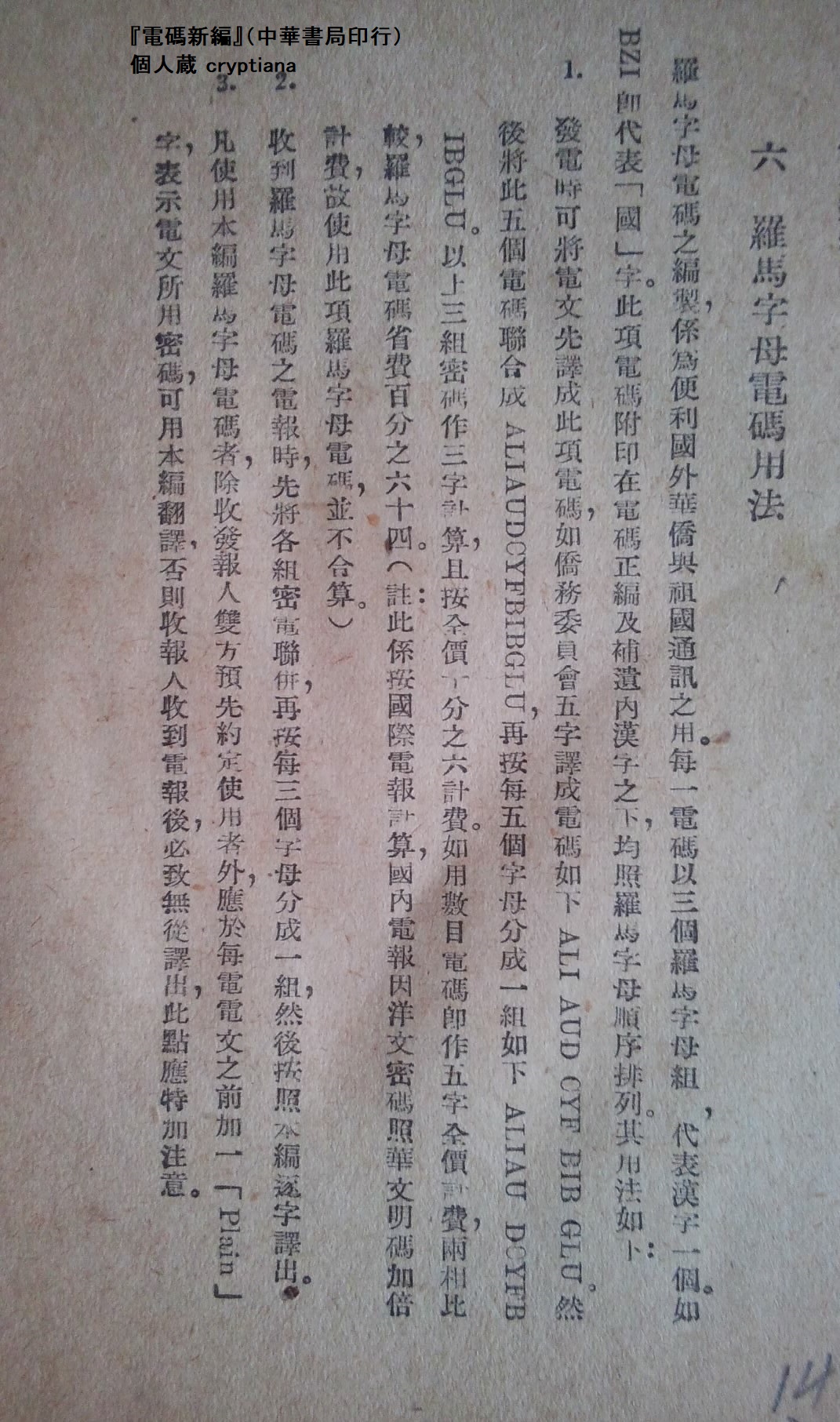
Versions simply titled Dian ma Xin bian were used from 1937 to 1952 (the year when the "Standard Telegraph Codebook" below was issued) in mainland China (Eiso Chan (2018), ISO/IEC JTC 1/SC 2/WG 2/IRG N2197 (pdf)). The verion I acquired (see images below), from a Zhonghua Book Company, appears to correspond to this. (Probably, it is the same as the version presented here.)
This employs traditional vertical reading and Chinese numerals but provides alphabetic three-letter code such as AKA (0260), AKH (0267), AKK (0270).

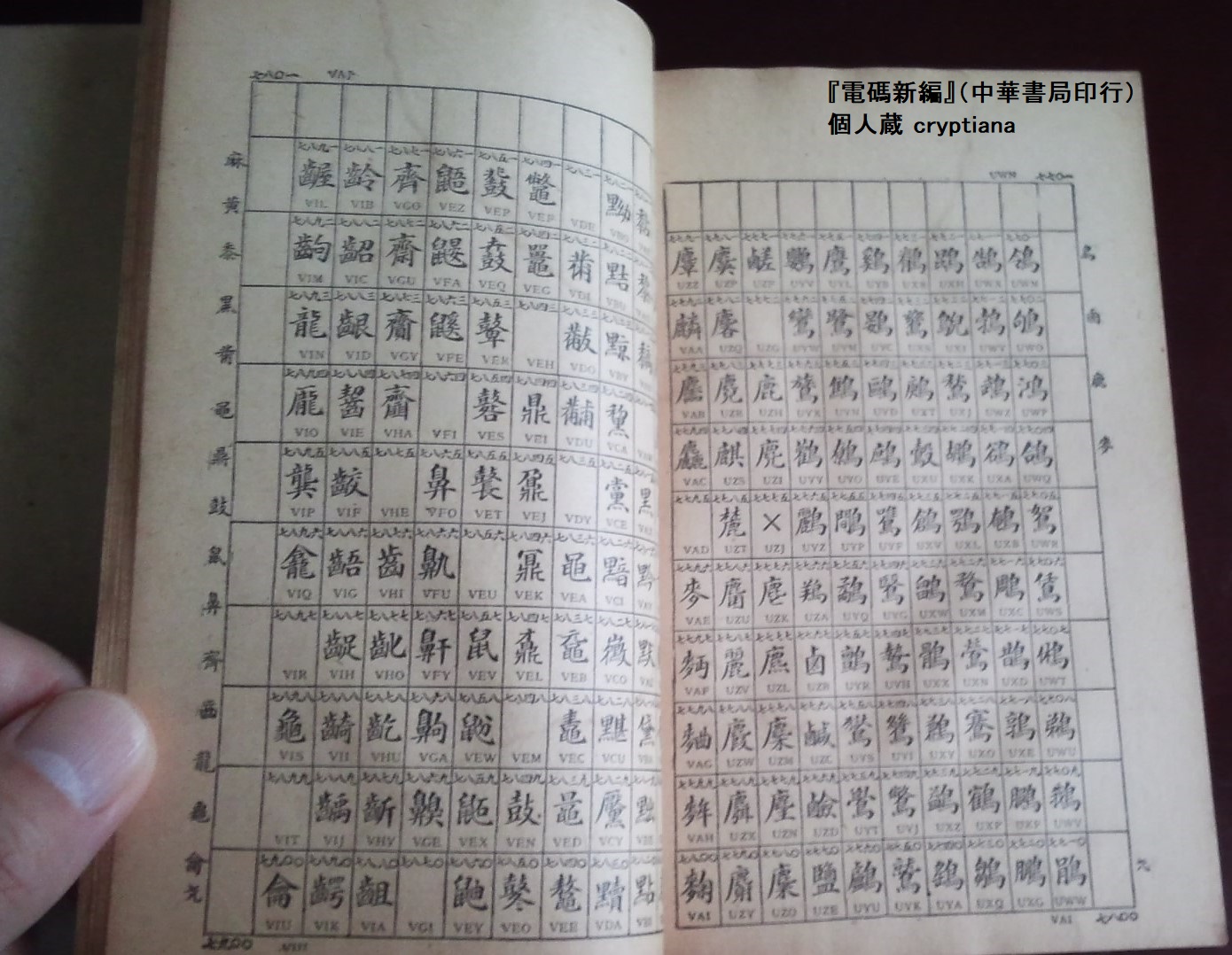
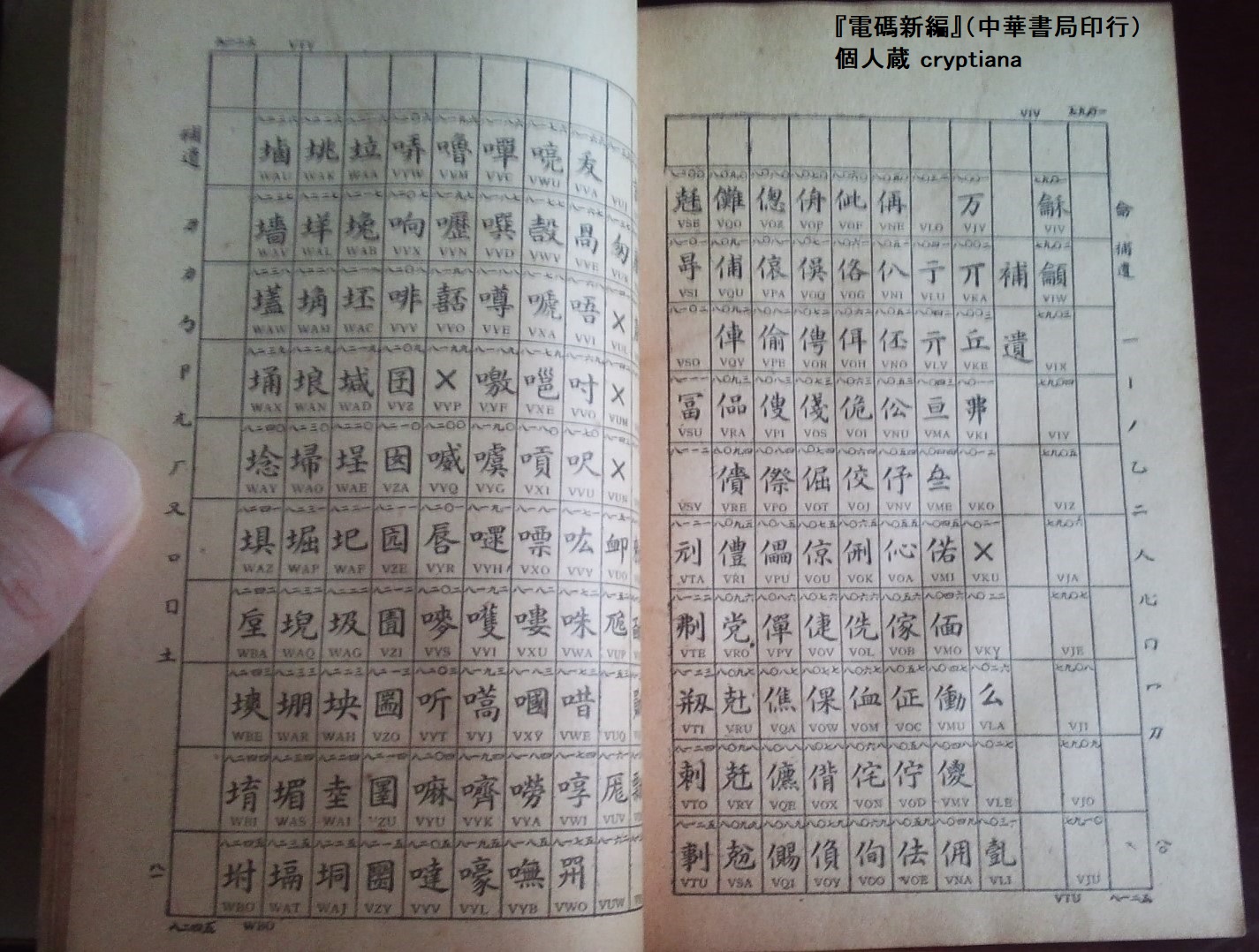
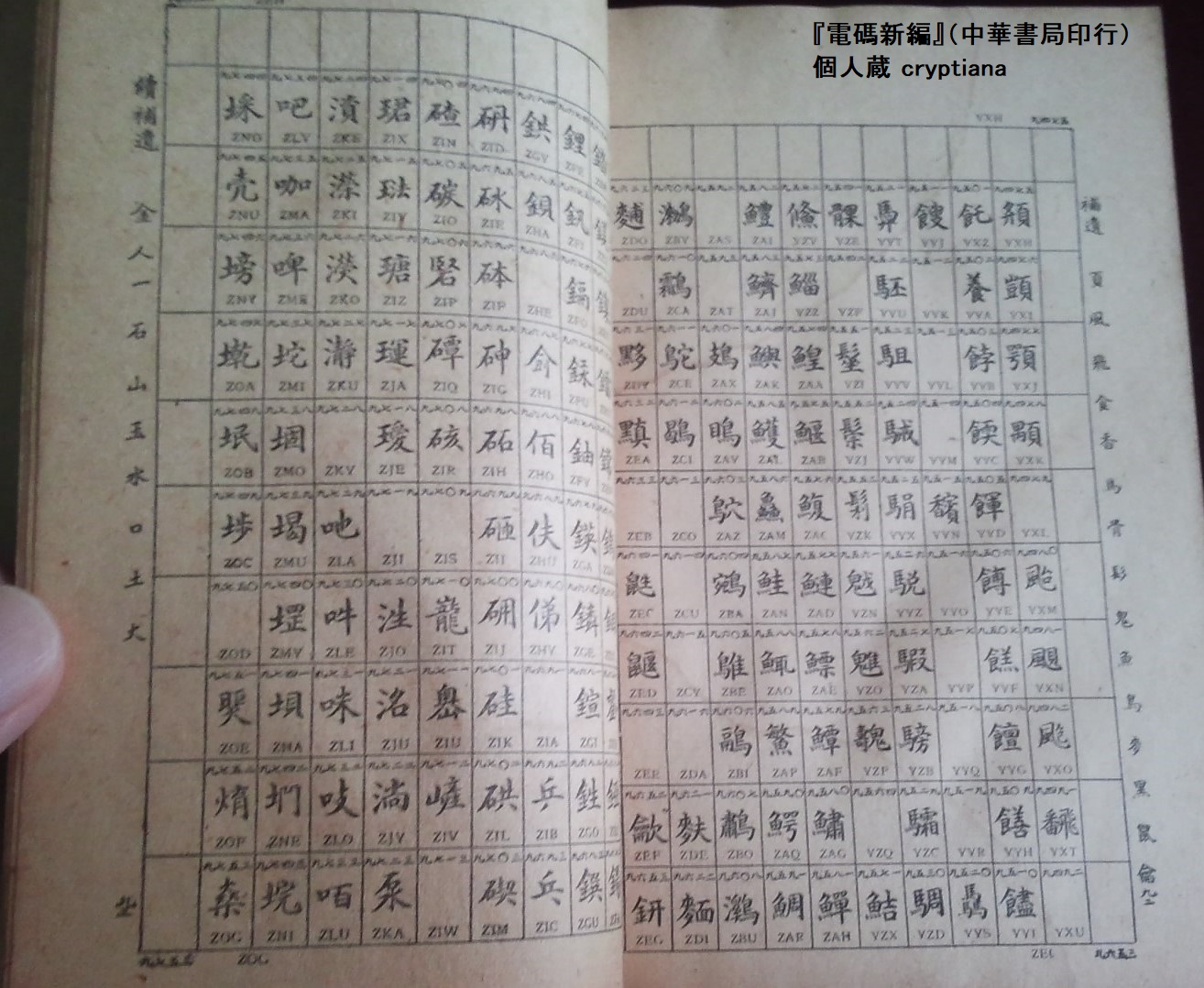


While Ming mi Ma Dian bao Shu (Commercial Press) and Ming mi Dian ma Xin bian or Dian ma Xin bian (Ministry of Transportation and Communications) above appear to have been the major editions, other publishers distributed their own editions with various titles.
A slightly different title (with an additional "ma") Ming mi ma dian ma xin bian (Kai ming Shu ju, 19--) is found on the web. Details unknown to the present author.
There are versions titled Ming mi Ma Dian bao Xin shu (with "Ming mi" printed as a small-letter prefix). Here and here are provided images of a copy presented to Zhang Xueliang. (The front cover says "1931" but the websites say "printed in 1921"). Specifically, images for two pages covering 6301-6500 are provided (vertical reading, Chinese numerals, no alphabetical letter code). The code assignment appears to be the same as that of Dian bao Xin bian (1881).
This particular copy has handwritten numbers written in the blank row/column on the top/edge. In the image, there is a handwritten number 78 in the margin of page 33, while the blanks on the left edge are filled with 9, 7, 6, 3, 0, 4, 5, 1, 8, 2 (from top to bottom) and those on the top are filled with 9, 7, 6, 3, 0, 4, 5, 1, 8, 2 (from right to left). With these, an alternative code number can be given by the page number (2 digits) + column number (on the top edge) + row number (on the left edge).
Here is an image of another version, providing two pages covering 3101-3300 (vertical reading, Chinese numerals, no alphabetical letter code). Again, the code assignment appears to be the same as that of Dian bao Xin bian (1881). There is a blank row/column on the top/edge of each page as above. Cover images of a different version with the same title are provided here and here. Further, CiNii says this is an alias for Zhonghua minguo Dian bao Xin bian.
Here are images for Ming mi ma Dian bao Xin shu (with "Ming mi ma" printed as a small-letter prefix). Specifically, image for three pages in the supplement covering 8591-8719 (p.84), 8720-9857 (p.85), 8858-9002 (p.86) are given (vertical reading, Chinese numerals, no alphabetical letter code). The code assignment appears to be the same as that of Dian bao Xin bian (1881, or at least its 1897 version given at Google), though many blank code numbers in the supplement of the latter are omitted. There is a blank row/column on the top/edge of each page as above.
Here (details here) are images of a 1937 edition. It employs traditional vertical reading and Chinese numerals (no alphabetical letter code). The code assignment appears to be the same as that of Dian bao Xin bian (1881).
There is a version from Shanghai (Baixin Shudian, 1947).
Google lists a 1952 edition (no preview).
Here is a front cover image of a 1949 Shanghai edition ("zui xin" means "latest, newest"), which says it is based on the version by the Ministry of Transportation and Communications. However, the bibliographic page uses the same title Ming mi ma dian bao xin bian as above. There is a blank row/column on the top/edge, which in this particular page is filled in with figures. While the image is not very clear, it appears to employ vertical reading direction, Arabic figures, and no alphabetical letter code.
Ming mi Dian ma Xin bian was called "Minma" in Japan and was used to represent Chinese names and place names. Even with secret code of the Japanese Army, "Minma" code numbers were used with indicators such as 4493, 9817. A cipher for an army air squadron (1933) (in Japanese) stipulates use of Ming mi Dian bao Xin shu.
Use was not limited to the military. There was a publication that provided an index of characters for facilitating lookup by Japanese users.
In 1949, the People's Republic of China was established and Chiang Kaishek's government evacuated to Taiwan.
In 1952, in the mainland, the Ministry of Post and Telegraph (You dian bu) issued Biao zhun Dian ma Ben (literally, "Standard Telegraphic Code Book"). It includes supplements of additional characters from code number 8001. (Some characters were moved from the main body to the supplement or vice versa. Many characters of the supplement were reassigned code numbers (information by Jaemin Chung)). Code numbers 9700 and upwards include codes for dates and hours (9701 January, ..., 9712 December, 9901 the 1st, ..., 9931 the 31st etc.), Zhuyin, Cyrillic letters, Latin letters, symbols (9998 space, 9999 linebreak, etc.).
In addition to the four-digit code numbers, there are alphabetical three-letter code groups. (Wikipedia (Japanese))
Google lists editions of 1952, 1955, 1960, 1972, 1983. CiNii lists editions of 1952.6, 1955.5 (2nd printing), 1967.12 (22nd), 1974.8 (26th), 1977.11 (28th).
This site provides an image of a 1961 edition (17th printing). It employs horizontal reading direction and there is a blank row/column on the top/edge. These features are the same as in the 1935 edition of Ming mi Dian ma Xin bian described above but there are a few differences (see 0026, 0051).
In 1983, the Standard Telegraphic Code Book underwent an extensive revision to adopt simplified characters. Moreover, 520 variant character forms and 1681 rarely used characters were removed, while 106 characters and 16 symbols were added, reducing the total number from 9300 to 7000 (Wikipedia (Japanese)).
The problem is: the simplified characters simply replaced the original characters, which disrupted the arrangement of characters according to the number of strokes. In order to alleviate the inconvenience in looking up a character, some characters that have a different radical from that of the original character are printed in blanks (originally provided for writing figures in) on the top row or the column to the edge. In addition, an index in pinyin was provided. (Characters in blanks and a pinyin index can be seen in images of the 1983 edition here. From the images of this website, it can also be seen that the leftmost code number in a row is xx00 (zero origin). Also, three-letter codes such as DWA (2600), DWB (2601), DWC (2602) can be seen.
Yasuoka et al. (2006) p.216 provides the first page of a 1981 edition (horizontal reading, alphabetical letter code, zero origin), in which many of the blanks on the top/edge are filled.
An image is found here (horizontal reading with zero origin; unsimplified characters; alphabetical letter code). The code assignment appears to be the same as that of Dian bao Xin bian (1881). The alphabetical letter codes such as GOB (2600), GOC (2601), GOD (2602) are completely different from those of the Standard Telegraphic Code Book above. In view of the country code "ja" at CiNii, the publisher Ryogen Shoten is the one in Japan. (Indeed, the pinyin form of the title above is not found in a Google search.)
HathiTrust (no preview)
Jian yi refers to "simple." This codebook was compiled by the Ministry of Post and Telegraph of China. No details known to the present author.
In 1972, Xin bian Biao zhun Dian ma Ben (Commercial Press) (ISBN 9789620720055) was published in Hong Kong. Google lists editions of 1972 and 1980. A cover image of a 1986 edition is found here (WorldCat) (ISBN is the same).
A Hong Kong website provides correspondence between the 1972 edition and Unicode. According to this website, there is now a Hong Kong edition different from the mainland edition and the Taiwan edition.
Google provides a cover image. Google provides a back cover image and gives a date of 1900. However, "1950s" given at WorldCat seems more plausible. WorldCat also lists an edition specified as 1964.
In 1950, the Ministry of Transportation and Communications of Taiwan published Dian ma Xin bian (Google (no preview)). In the cover image of a 1988 edition here, the title is accompanied with an English version "TELEGRAPH CODE (CHINESE CHARACTER IN FIGURES)." Here is another image of what appears to be the same edition.
Google further lists editions of 1976 and 1981. The 1976 edition is also listed in a library catalogue and WorldCat.
Google lists a 1969 edition as from Zhonghua Book Company.
By the way, Zhong wen Ying wen Dian ma Xin bian (literally, "Chinese-English Telegraphic Code New Compilation") (Taiwan, Zhonghua Book Company, 196?), found in a catalogue, seems to be interesting.
Here are some images of a code based on the edition of the Ministry of Transportation and Communications. The website says it is compiled and published by Chen Shun Qi, who is also an author of Shou wei hao ma ci dian (1965) etc.
It employs horizontal reading direction (but the book opens from left to right) and there is a blank row/column on the top/edge. The assignment of code numbers (in Arabic figures) appears to be the same as that of Dian bao Xin bian (1881). Alphabetical three-letter code groups are provided.
On the top of the page, anti-communist slogans are printed in large font.
Google lists a 1975 edition published by Da Zhong guo Tu Shu (no preview).
A cover image of a 1963 edition published by Da Zhong guo Tu Shu can be seen here. A 1966 edition is listed here and CiNii. Earlier on, a 1954 edition is listed at Google and WorldCat. Further, a 1982 edition is listed at Google.
A cover image of a 1998 edition published by Hong yang Tu Shu, which seems to be closely related to Da Zhong guo Tu Shu, can be seen here. A 2013 edition (ISBN�F9789866073366) is listed here.
An edition published by Yong xin Shu ju in Hong Kong is listed in a catalogue.
Since the telegraphic code of Taiwan has been amended independently from that of the People's Republic of China, there is a great variance between the two versions in the supplements. Further, the alphabetical three-letter code is quite different except for the beginning part. Further, since in the mainland, removal etc. has been done in the body before the supplement, there are also differences in the main part.
As noted in the beginning of the present article, Chinese telegraphic code is used in law enforcement/immigration control. Moreover, it has had its influence on the character code used for computers. The CJK Unified Ideographs (aggregation of Chinese characters used in China, Japan, and Korea) defined in Unicode includes 58 Chinese characters that were not included in Chinese computer code but were included in the Standard Telegraphic Code Book of 1983 (Yasuoka et al. (2006); Wikipedia (Japanese))�D
As noted in the beginning, in Europe, America, and Japan, there were many telegraphic codebooks for representing words and phrases with single code groups to reduce telegraph fees. Such a codebook was also made in China.
As for governmental secret codebooks for international communication, there were Dian ju Ji jin (�d��W��) (1880) by Zeng Jize (�]�I��) (5-digit figure code); Dian bao Jian bian (�d��ȕ�) (1881) by Li Fengbao (���P�) (3-letter code); and Ziju Dianmashu (����d����) by Zhang Yanxiang (������) at the time of the Second Sino-Japanese War. See another article.
Images are found here and here. A notice in a magazine (Funu zashi, 5 July 1915) says "Ministry of Transportation and Communications approved / Can be used at every telegraph station."
According to the Introduction in English, Dian bao Xin bian by the telegraph authority, which was the "only" telegraph code at the time, was no more than a character code. The deficiency is addressed by this codebook, which was modelled after Western codebooks such as Western Union Telegraphic Code, Bentley's Complete Phrase Code, ABC Telegraphic Code. It contains more than 100,000 entries under various classifications. Each entry provides a five-figure code number and an alphabetical five-letter code group, either of which can be used for transmission.
p.628-647 includes a figure code which represents various information such as goods, quality, and price with digits of a five-figure number. The user is supposed to understand Chinese but it appears English equivalents for terms are given in the appendix.
This title is found at a library catalogue.
This was published by the Ministry of Transportation and Communications. Some images can be seen here.
The Chinese language uses thousands of different characters and it was inevitable that five-figure code numbers should be used to represent words and phrases as well as single characters. Further, alphabetical code words consist of four letters instead of three. For example, the character "��" (meaning up/above) may be represented by a five figure code "02305" or a four-letter code "ANLF."
The first three digits of five-figure code numbers and the first two letters of alphabetical four-letter code groups are printed in the top corner of each page. The columns are headed by numbers 0, 1, 2, 3, 4, 5, 6, 7, 8, 9 as well as letters L, M, P, R, S, T, U, W, Y, Z (from left to right) and rows are headed (on the left) by numbers 0, 1, 2, 3, 4, 5, 6, 7, 8, 9 as well as letters A, B, C, D, E, F, G, H, J, K. For example, on the top-left corner of page 24, there are "023" and "AN" printed in a square. Since the character "��" is found on the zeroth column ("L") and the fifth row ("F"), the five-figure code number is 02305 and the four-letter code group is "ANLF." Similarly, "��j��" (meaning "the above two codes") may be represented by 02316 or ANMG.
This Hong Kong website provides correspondence between Chinese Telegraph Code and Unicode. The telegraph code is based on the Standard Telegraphic Code Book of 1972 but also shows different versions. (Apparently, ad pages opening up every time the page is accessed can be closed without doing no harm.)
This website provides a table in text that shows characters and their code numbers.
NJStar Software provides a tool for converting a Chinese character into telegraph codes as Chinese Commercial/Telegraphic Code Lookup. Code numbers of both the mainland China version and the Taiwan version are provided. There are also browsable lists: Chinese Telegraphic Code Book for Mainland China and Chinese Telegraphic Code Book for Taiwan. Moreover, a brief history of Chinese character code from the Standard Telegraph Codebook is reproduced in images and Chinese text.